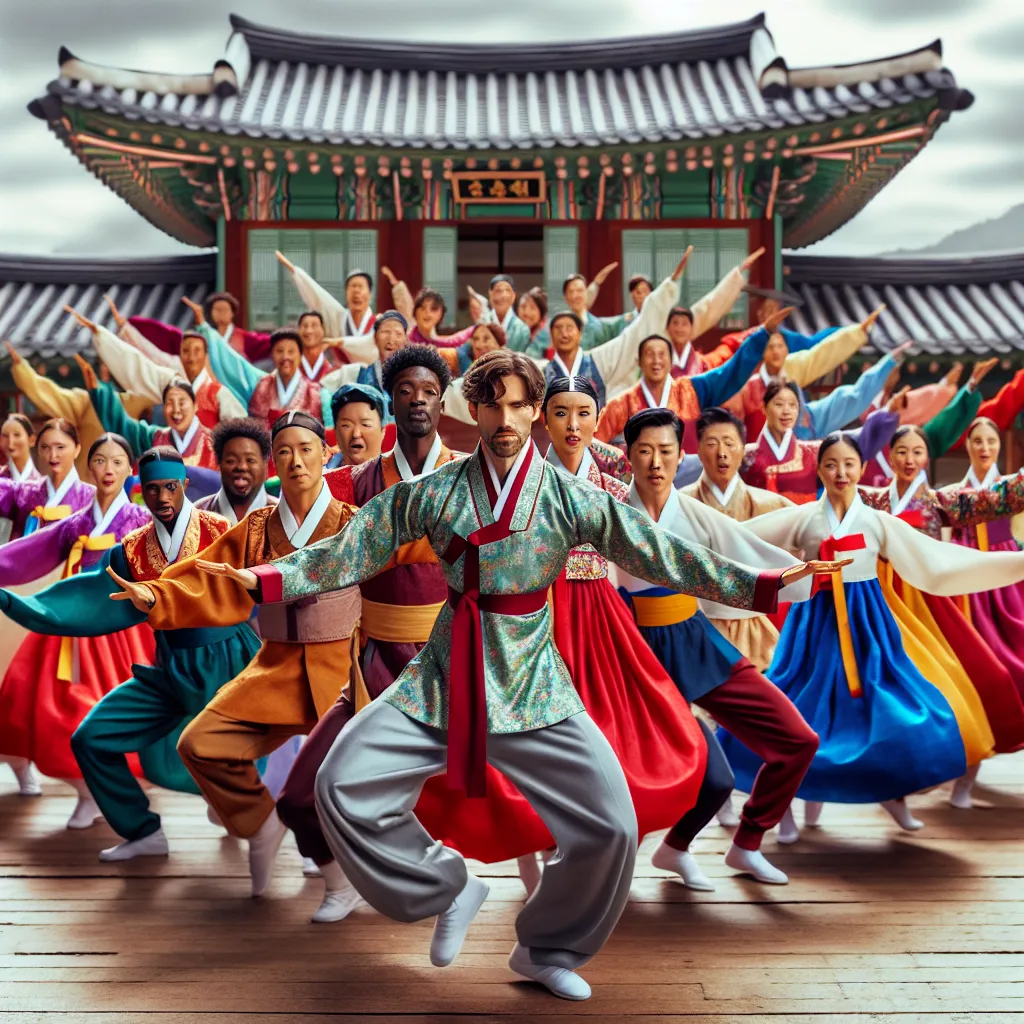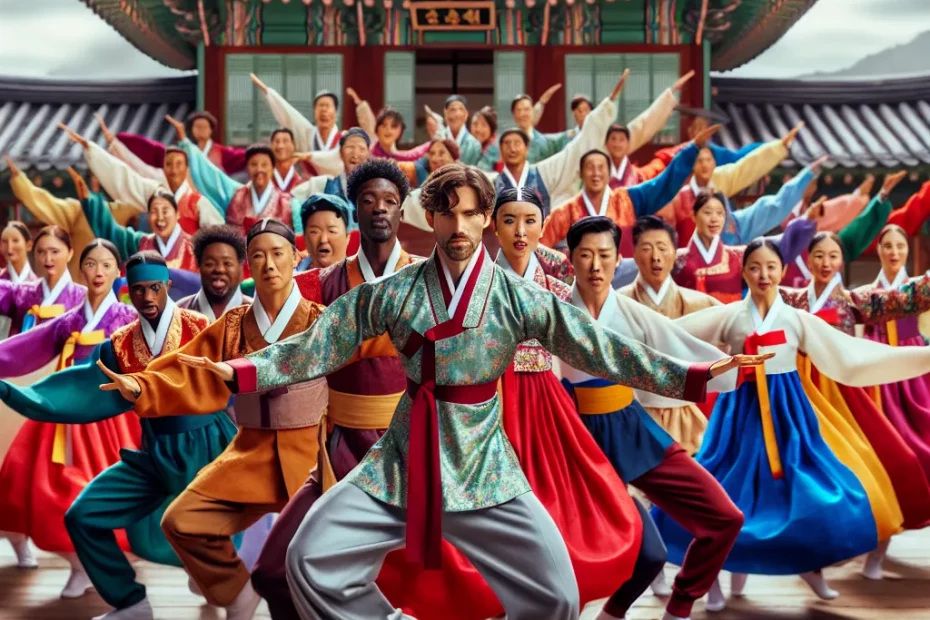Korean traditional dance is a vibrant reflection of the country’s rich cultural heritage, encompassing a diverse range of styles and influences. From graceful movements to intricate costumes, each aspect of Korean traditional dance tells a story of the nation’s history and traditions. As we delve into the depths of this art form, we uncover a tapestry of regional customs and unique dance styles that have been passed down through generations. The preservation efforts and modern adaptations of Korean traditional dance continue to breathe new life into this ancient art, ensuring that it remains a vital part of Korea’s cultural identity. Join me on a journey through the captivating world of Korean traditional dance, where history, artistry, and diversity converge to create a mesmerizing spectacle that transcends time and borders.

The Rich History of Korean Traditional Dance
Korean traditional dance, known as “Choom” in Korean, boasts a rich history that dates back thousands of years. This cultural heritage has been passed down through generations, embodying the essence of Korea’s cultural diversity and artistic expression. 🌟
The Origins of Korean Traditional Dance
The origins of Korean traditional dance can be traced back to ancient shamanistic rituals, where dance was used as a form of worship and communication with the divine. Over time, these ritualistic dances evolved into various forms, each with its unique movements, costumes, and music. 💫
Forms of Korean Traditional Dance
One of the most well-known forms of Korean traditional dance is “Salpuri,” a spiritual dance performed to cleanse the mind and body of negative energy. The graceful movements and flowing costumes of the dancers captivate audiences and transport them to a world of beauty and tranquility. 🌺
Another popular form of Korean traditional dance is “Fan Dance,” where dancers use colorful fans to create intricate patterns and movements. This dance symbolizes the harmony between nature and humanity, with each movement reflecting the beauty of the natural world. 🌿
Significance of Korean Traditional Dance
Korean traditional dance is not only a form of artistic expression but also a reflection of Korea’s history and cultural identity. It embodies the values and beliefs of the Korean people, showcasing their resilience, creativity, and spiritual connection to the world around them. 🎭
Today, Korean traditional dance continues to thrive, with dedicated practitioners preserving and promoting this ancient art form. Through performances, workshops, and cultural events, Korean traditional dance remains a vibrant and integral part of Korea’s cultural landscape. Let us celebrate and honor the rich history of Korean traditional dance, a true testament to the beauty and diversity of Korean culture. 🌸
Influence of Regional Customs on Korean Dance Styles
The rich tapestry of Korean traditional dance is intricately woven with the diverse regional customs and cultural practices found throughout the Korean peninsula. Each region in Korea boasts its unique set of traditions, beliefs, and rituals, which have significantly influenced the development and evolution of various Korean dance styles.
Regional Influence on Korean Dance Styles
From the graceful movements of the court dances in the royal palaces of Seoul to the dynamic and energetic performances of the folk dances in the rural areas of Jeju Island, the regional customs of Korea have left an indelible mark on the country’s dance heritage. For example, the Ganggangsullae dance from the Jeolla provinces is a communal circle dance performed under the bright full moon during harvest festivals, reflecting the agricultural traditions and close-knit community spirit of the region. The intricate footwork and hand gestures of this dance symbolize the unity and cooperation necessary for a successful harvest season.
In contrast, the Buchaechum fan dance, originating from the noble classes of the Joseon dynasty in Seoul, embodies the refined elegance and sophistication of the royal court. The dancers’ precise movements with colorful fans represent the grace and beauty of Korean court culture, showcasing the aristocratic customs and traditions of the capital city.
Furthermore, the mask dances of Hahoe in Andong highlight the spiritual beliefs and shamanistic rituals of the region. These masked performances, often accompanied by traditional music and storytelling, serve as a form of exorcism and protection against evil spirits, reflecting the deep-rooted customs and superstitions of the Andong area.
The regional diversity in Korean dance styles is not only a testament to the country’s cultural richness but also a reflection of the interconnectedness between tradition and innovation. As dancers continue to pay homage to their regional customs while embracing modern influences, Korean traditional dance remains a vibrant and evolving art form that celebrates the past while looking towards the future.
In conclusion, the influence of regional customs on Korean dance styles is undeniable, shaping the unique characteristics and aesthetics of each dance form. By honoring and preserving these regional traditions, Korean dancers pay tribute to the cultural diversity and heritage that define the essence of Korean traditional dance. Let us continue to celebrate the beauty and diversity of Korean dance, where the past meets the present in a harmonious dance of tradition and innovation! 🌟🎶🌺
Traditional Costumes and Props in Korean Dance
Korean traditional dance is a vibrant art form that beautifully showcases the rich cultural heritage of Korea. One of the key elements that make Korean dance so captivating is the traditional costumes and props used by the performers. These costumes are not just clothing; they are a reflection of Korea’s history, tradition, and cultural diversity.
The Hanbok
The Hanbok, a traditional Korean dress, plays a significant role in Korean dance. The flowing lines and vibrant colors of the Hanbok add grace and elegance to the dancers’ movements. The intricate embroidery and patterns on the Hanbok often symbolize elements of nature, such as flowers, birds, and trees, adding layers of meaning to the performance.
Props in Korean Dance
In addition to the Hanbok, Korean dancers also use a variety of props to enhance their performances. One iconic prop is the Buchaechum, or traditional Korean fan dance. The dancers use colorful fans to create mesmerizing patterns and movements, symbolizing elements of nature and expressing emotions through dance.
Another essential prop in Korean dance is the Janggu, a traditional double-headed drum. The rhythmic beats of the Janggu provide a powerful soundtrack to the dancers’ movements, adding depth and intensity to the performance. The Janggu is not just a musical instrument; it is a symbol of Korean traditional music and culture.
The use of traditional costumes and props in Korean dance is not just for aesthetic purposes; it is a way to preserve and pass down Korea’s cultural heritage to future generations. Through these costumes and props, dancers are able to connect with their roots, express their identity, and celebrate the beauty of Korean culture.
In conclusion, the traditional costumes and props in Korean dance play a crucial role in expressing Korea’s cultural diversity and heritage. From the elegant Hanbok to the dynamic Janggu, these elements add depth, meaning, and beauty to Korean dance performances, captivating audiences and preserving Korea’s rich cultural legacy for generations to come. Let the beauty and grace of Korean traditional dance continue to inspire and enchant audiences around the world! 🌸🎶🇰🇷
Preservation Efforts and Modern Adaptations of Korean Traditional Dance
In the realm of cultural heritage, Korean traditional dance stands as a vibrant tapestry woven with the threads of history, tradition, and artistic expression. Efforts to preserve and promote this rich legacy have been paramount in safeguarding Korea’s cultural diversity. With over 50 traditional dance forms recognized by the Korean government, each with its unique movements, costumes, and musical accompaniments, the landscape of Korean traditional dance is as diverse as the nation itself 🌟.
Preservation Initiatives
Preservation initiatives have played a crucial role in maintaining the authenticity and essence of Korean traditional dance. Institutions such as the National Gugak Center have been at the forefront of these efforts, documenting and archiving traditional dance performances, costumes, and musical scores. Through meticulous research and preservation techniques, these institutions ensure that the intricate details and nuances of each dance form are faithfully passed down through generations 📚.
Modern Adaptations
Moreover, modern adaptations of Korean traditional dance have breathed new life into this ancient art form, allowing it to resonate with contemporary audiences around the globe 🌍. Choreographers and dancers have ingeniously blended traditional movements with modern aesthetics, creating innovative performances that bridge the gap between the past and the present. By infusing traditional dance with elements of technology, multimedia, and interdisciplinary collaboration, Korean traditional dance continues to evolve and captivate audiences of all ages 👏.
One remarkable example of modern adaptation is the fusion of traditional fan dance with contemporary music and visual effects. By incorporating electronic music beats and stunning light displays, traditional fan dance performances have taken on a futuristic and dynamic quality, appealing to younger audiences and breaking traditional boundaries. This innovative approach not only preserves the essence of the dance but also ensures its relevance in a rapidly changing world 🎶.
In conclusion, the heritage of Korean traditional dance is a testament to the enduring spirit of Korea’s cultural identity. Through preservation efforts and modern adaptations, this art form continues to thrive and inspire, showcasing the beauty and diversity of Korean culture to the world. As we look to the future, it is essential to uphold the legacy of Korean traditional dance, ensuring that it remains a vibrant and integral part of Korea’s cultural landscape for generations to come 💃🎉.
In conclusion, the heritage of Korean traditional dance is a vibrant reflection of Korea’s rich cultural diversity and history. From the graceful movements to the intricate costumes and props, Korean traditional dance embodies the essence of Korean identity and tradition. The influence of regional customs on dance styles adds depth and variety to the art form, showcasing the unique characteristics of each region. Through preservation efforts and modern adaptations, Korean traditional dance continues to evolve and thrive, captivating audiences worldwide with its beauty and grace. Embracing the past while looking towards the future, Korean traditional dance remains a timeless art form that celebrates Korea’s cultural heritage and artistic expression.
